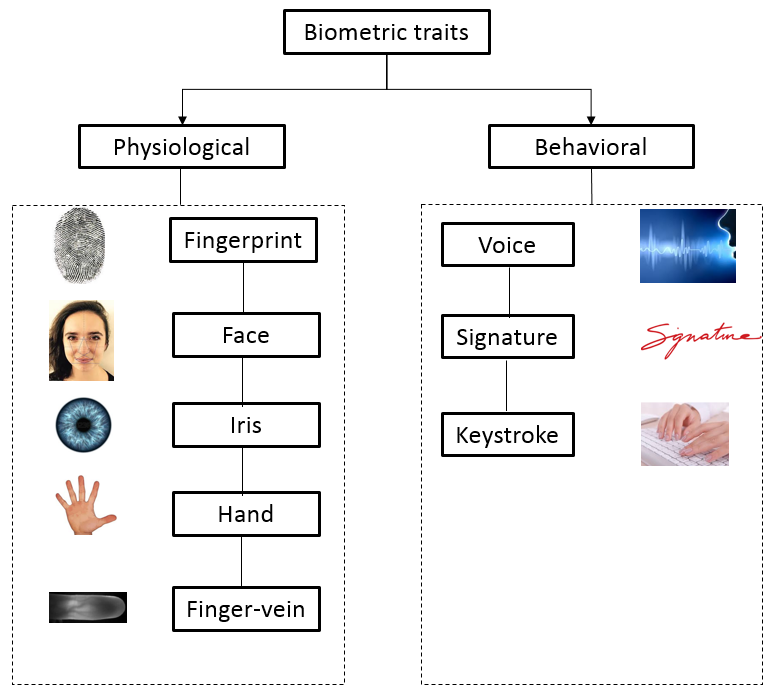Q. Which of the following are some important pollutants released by steel industry in India?
- Oxides of sulphur
- Oxides of nitrogen
- Carbon monoxide
- Carbon dioxide
Select the correct answer using the code given below
(a) 1, 3 and 4 only
(b) 2 and 3 only
(c) 1 and 4 only
(d) 1, 2, 3 and 4
Answer: (d) 1, 2, 3 and 4
Steel Industry
- Steel is ‘iron with most of the carbon removed’, Steel is primarily sourced from iron ore, and 98% of mined iron ore goes into manufacturing steel.
- Iron constitutes about five per cent of the Earth’s crust and is the fourth most abundant element in the crust.
- Steel is an essential commodity since it facilitates many other industries including construction, automobile, machinery, electrical equipment, and a variety of products ranging from cookware to furniture.
- India is the second-largest steel producer in the world.
- The main pollutants are particulate matter, oxides of sulphur and nitrogen, and carbon monoxide along with high emissions of carbon dioxide.
- Coke (mostly carbon), reacts with the blast air to produce carbon monoxide, which, in turn, reacts with the iron oxide to produce carbon dioxide and metallic iron.
Iron ore
- Iron doesn’t occur naturally. Being highly reactive, it combines easily with other minerals to form ores. Those with the highest iron content are found near the surface of the earth and are relatively easy to mine.
- The principal iron ores are hematite (Fe2O3) and magnetite (Fe3O4).
- Most iron ore is extracted through opencast mines.
- To be economically viable for mining, iron ore must contain at least 20% iron.
Limestone
- Limestone is calcium carbonate (CaCO3). It is mainly composed of the skeletal remains of marine organisms.
- Geologically, limestone occurs as a sedimentary layer over bedrock. As such it is relatively easy to extract through quarrying.
- Limestone is removed from the quarry, crushed and transported to steel mills.
Coke
- Coke is produced from coal. The coal is heated, or ‘carbonised’ in an oven until it becomes coke. It is then removed from the oven and cooled before use in the blast furnace.
- The coal gas produced during carbonisation is collected and used as a fuel in the manufacturing process while by-products such as tar, benzole and sulphur are extracted for further refining.
Environmental impact of Steel production
- Steel production has a number of impacts on the environment, including air emissions (CO, SOx, NOx, PM2), wastewater contaminants, hazardous wastes, and solid wastes. The major environmental impacts from integrated steel mills are from coking and iron-making.
- Climate change
- Virtually all of the greenhouse gas emissions associated with steel production are from the carbon dioxide emissions related to energy consumption.
- Emissions to air
- Coke production is one of the major pollution sources from steel production. Air emissions such as coke oven gas, naphthalene, ammonium compounds, crude light oil, sulfur and coke dust are released from coke ovens.
- Emissions to water
- Water emissions come from the water used to cool coke after it has finished baking. Quenching water becomes contaminated with coke breezes and other compounds. While the volume of contaminated water can be great, quenching water is fairly easy to reuse. Most pollutants can be removed by filtration.
- Waste
- Slag, the limestone and iron ore impurities collected at the top of the molten iron, make up the largest portion of iron-making by-products. Sulfur dioxide and hydrogen sulfide are volatized and captured in air emissions control equipment and the residual slag is sold to the construction industry. While this is not a pollution prevention technique, the solid waste does not reach landfills.
- Gaseous emissions and metal dust are the most prominent sources of waste from electric arc furnaces.
National Steel Policy 2017
- The National Steel Policy which was released in 2017 aims to attain a steel production capacity in India of 300 MT by 2030.
- It has a long-term vision to enhance domestic consumption, produce high-quality steel and make the sector globally competitive.
- The policy’s mission is to create an environment that enables:
- Self-sufficiency in the production of steel by giving policy
- support and guidance to MSME producers of steel, the private sector, central public sector enterprises and boost sufficient capacity additions.
- Development of internationally competitive manufacturing capabilities.
- Increase in the domestic demand for steel.
- Cost-efficient production and domestic availability of iron ore, coking coal and natural gas.
- Investment in overseas asset acquisitions of raw materials.
Green Steel
- Green Steel is the manufacturing of steel without the use of fossil fuels.
- This can be done by using low-carbon energy sources such as hydrogen, coal gasification, or electricity instead of the traditional carbon-intensive manufacturing route of coal-fired plants.
- It eventually lowers greenhouse gas emissions, cuts cost and improves the quality of steel.
- Low-carbon hydrogen (blue hydrogen and green hydrogen) can help reduce the steel industry’s carbon footprint.
- Ways of Production:
- Substituting the Primary Production Processes with Cleaner Alternatives:
- Carbon capture, utilization and storage (CCUS).
- Replacing conventional sources of energy with low-carbon hydrogen.
- Direct electrification through electrolysis of iron ore.
- Substituting the Primary Production Processes with Cleaner Alternatives:
- Significance:
- The steel industry is the largest industrial sector in terms of intensive energy and resource use. It is one of the biggest emitters of carbon dioxide (CO2).
- In view of commitments made at the Conference of the Parties (COP26) climate change conference, the Indian steel industry needs to reduce its emissions substantially by 2030 and hit net-zero carbon emissions by 2070.
Q. Lichens, which are capable of initiating ecological succession even on a bare rock, are actually a symbiotic association of
(a) Algae and bacteria
(b) Algae and fungi
(c) Bacteria and fungi
(d) Fungi and mosses
Answer: (b) Algae and fungi
Lichens
- Lichen is a composite organism that arises from algae or cyanobacteria living among filaments of multiple fungi species in a mutualistic relationship.
- Lichens are important actors in nutrient cycling and act as producers which many higher trophic feeders feed on, such as reindeer, gastropods, nematodes, mites, and springtails.
- Lichens do not have roots that absorb water and nutrients as plants do, but like plants, they produce their own nutrition by photosynthesis. When they grow on plants, they do not live as parasites, but instead use the plant’s surface as a substrate.
- Lichens occur from sea level to high alpine elevations, in many environmental conditions, and can grow on almost any surface. They are abundant growing on bark, leaves, mosses, or other lichens and hanging from branches “living on thin air” (epiphytes) in rainforests and in temperate woodland. They grow on rock, walls, gravestones, roofs, exposed soil surfaces, rubber, bones, and in the soil as part of biological soil crusts. Various lichens have adapted to survive in some of the most extreme environments on Earth: arctic tundra, hot dry deserts, rocky coasts, and toxic slag heaps. They can even live inside solid rock, growing between the grains (endolithic).
- It is estimated that 6–8% of Earth’s land surface is covered by lichens.
- Lichens are a keystone species in many ecosystems and benefit trees and birds.
Algae
- Algae are in another kingdom (Protista) separate from plants and fungi. Algae are chlorophyll-bearing, simple, thalloid, aurotrophic and largely aquatic plants.
- They occur in moist stones, soils, and wood or in association with fungi and animals.
- There are several types of algae: green, brown, red, gold. They can survive in salt water and in freshwater on their own, and in any environment when part of a lichen relationship.
- Although cyanobacteria are called blue-green algae, they are actually bacteria, and are part of the bacteria kingdom, Monera. The “blue” in the common name refers to the fact that they need to live in water, and “green algae” refers to their photosynthetic abilities, like green algae.
Fungi
- Fungi are a diverse group of organisms that are in their own kingdom (Fungi), separate from plants.
- Fungi is a Eukaryotic organism that includes micro-organism such as yeast, moulds and mashrooms.
- Fungi do not contain chlorophyll or any other means of producing their own food so they rely on other organisms for nutrition.
- Fungi are widely known for their role in the decomposition of organic matter. They are also necessary for the survival of the ecosystem around them, such as partnering with plants and trees for nutrients and survival.
- Lichens are another such partnership for fungi to gain nutrients from another organism. The algal partner photosynthesizes and provides food for the fungus, so it can grow and spread.
Bacteria
- Bacteria are microscopic, single-celled organisms that exist in their millions, in every environment.
- They constitute a large domain of prokaryotic microorganisms.
- Bacteria were among the first life forms to appear on Earth.
Mosses
- Mosses are a phylum of non-vascular plants.
- They produce spores for reproduction instead of seeds and don’t grow flower, wood or true roots.
Q. Which one of the following is the process involved in photosynthesis?
(a) Potential energy is released to form free energy
(b) Free energy is converted into potential energy and stored
(c) Food is oxidized to release carbon dioxide and water
(d) Oxygen is taken, and carbon dioxide and water vapour are given out.
Answer: (b) Free energy is converted into potential energy and stored
Photosynthesis
- Photosynthesis is a biological process used by many cellular organisms to convert light energy into chemical energy, which is stored in organic compounds that can later be metabolized through cellular respiration to fuel the organism’s activities.
- During photosynthesis in green plants, light energy is captured and used to convert water, carbon dioxide, and minerals into oxygen and energy-rich organic compounds.
- Most plants, algae and cyanobacteria perform photosynthesis; such organisms are called photoautotrophs.
- Photosynthesis is largely responsible for producing and maintaining the oxygen content of the Earth’s atmosphere, and supplies most of the biological energy necessary for complex life on Earth.
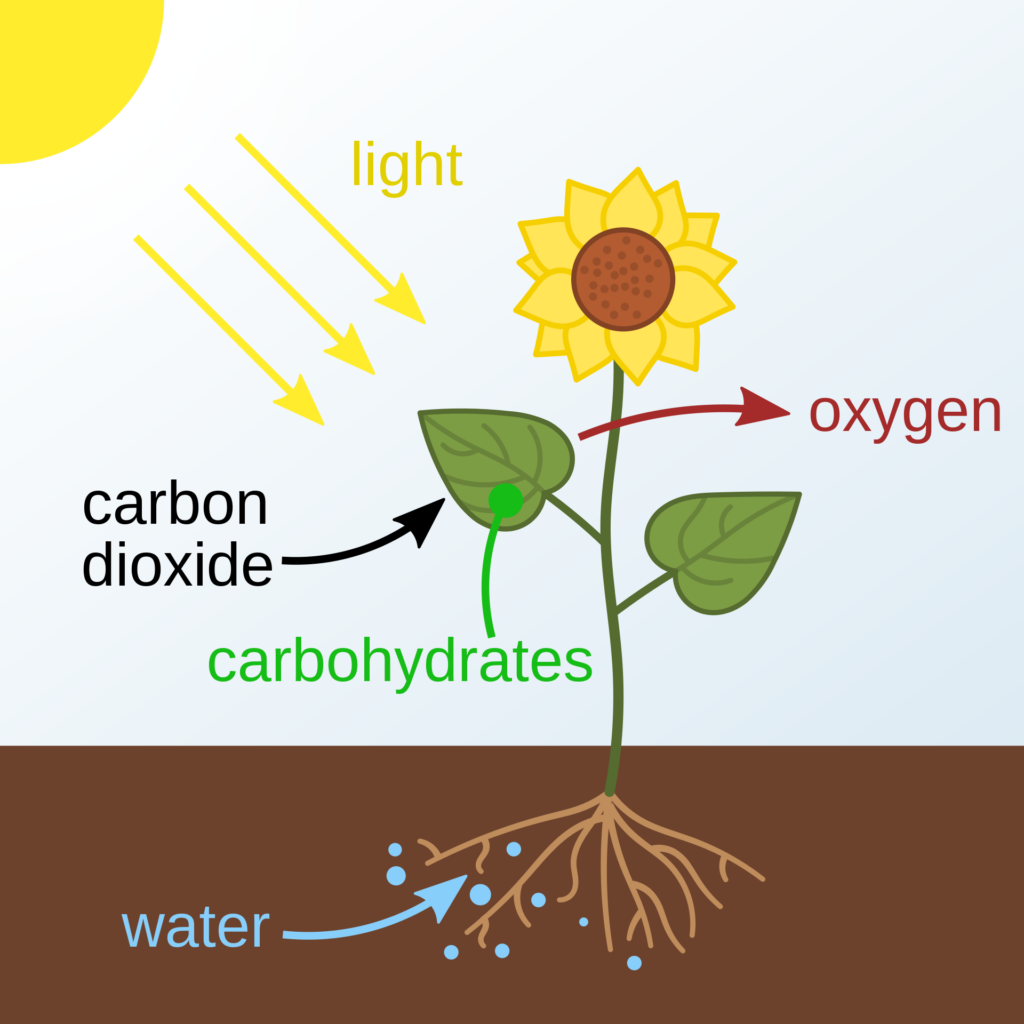
Q. Which of the following is/are the example/examples of chemical change?
- Crystallization of sodium chloride
- Melting of ice
- Souring of milk
Select the correct answer using the code given below.
(a) 1 and 2 only
(b) 3 only
(c) 1, 2 and 3
(d) None
Answer: (b) 3 only
Chemical Change
- When one chemical substance is transformed into one or more different substances, it is called a chemical change. The most common example is when iron transforms into rust.
- Crystallization of sodium chloride
- When the solubility limit of NaCl exceeds, the crystallization of NaCl takes place.
- It is a physical change since sodium chloride does not transform into some other chemical element after crystallization.
- Melting of ice
- Ice is the solid form that liquid water takes when it is cooled below 0 degrees celsius.
- When the temperature rises, solid ice changes into liquid water.
- It is not a chemical change since the composition of water molecules stays the same before and after melting.
- Souring of milk
- Lactic acid bacteria ferment lactose at room temperature and turn it into lactic acid.
- As a result, the acidity of the milk increases, which in its turn causes the protein to fold and liquid to separate into whey and a viscous mass.
- The soured milk has new elements and it cannot be reversed. Hence, it is a chemical change.

Q. Which of the following statements is/are correct regarding vegetative propagation of plants?
- Vegetative propagation produces clonal population.
- Vegetative propagation helps in eliminating the virus.
- Vegetative propagation can be practiced most of the year.
Select the correct answer using the code given below.
(a) 1 only
(b) 2 and 3 only
(c) 1 and 3 only
(d) 1, 2 and 3
Answer: (c) 1 and 3 only
Vegetative Propagation
- It is an asexual method of plant reproduction that occurs in its leaves, roots and stem.
- It is often used when the crop plants either do not produce seeds or when the seeds produced are not viable or are of long dormancy.
- Some of the commonly seen examples of Vegetative Propagation are
- Roses are often multiplied by planting their cuttings which include stem cuttings.
- Mint plant, which is seen in the kitchen garden grows and spreads quickly with the help of its underground stems called stolons, which grow roots and leaves.
- Tulips are grown on a large scale for ornamental purpose by colelcting their Bulbs and then planting them.
- Cherry and Apple trees can be propagated using shoots called suckers, which are found at the base of the tree.
- Vegetative propagation can be practised most of the year. Vegetative propagation can occur naturally or be induced artificially by a technique called Artificial Vegetative Propagation.
- Natural Vegetative Propagation
- This occurs when plants grow and develop naturally without any human interference. Natural vegetative propagation can be enabled by the development of adventitious roots. Thus, new plants may emerge from the roots, stem and leaves of the parent plant.
- The vegetative plant structures arising from the stem are known as rhizomes, bulbs, runners, tubers, etc.
- Artificial Vegetative Propagation
- This is a type of vegetative reproduction carried out by humans in the fields and laboratories.
- The part of a plant that is used for artificial vegetative propagation is called vegetative propagule. These methods are beneficial to retain desirable traits like flavor, color, disease resistance, etc.
- Natural Vegetative Propagation
- The widespread use of vegetative propagation results in the spread of viruses through propagules such as cuttings, tubers, runners and bulbs. A plant once systemically infected with a virus usually remains infected for its lifetime.
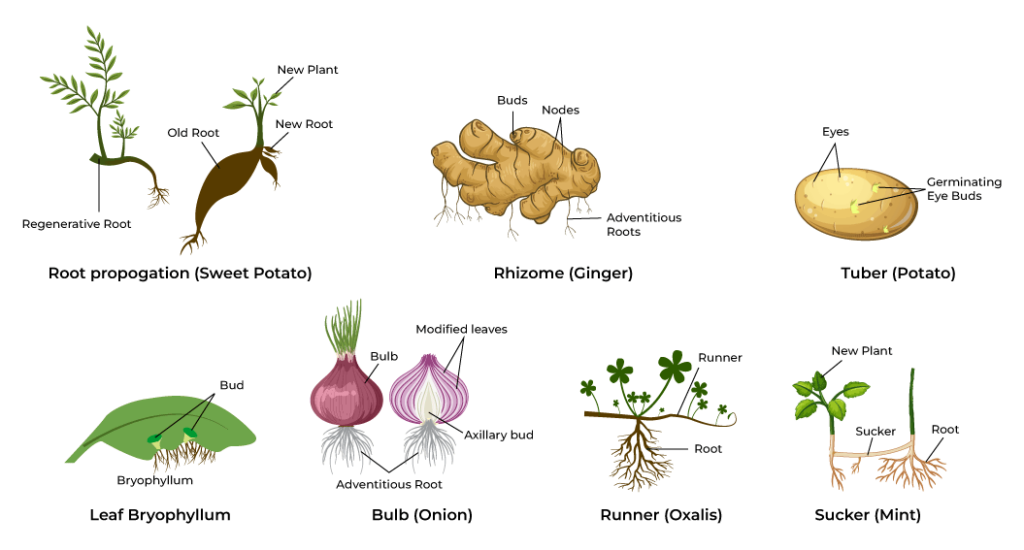
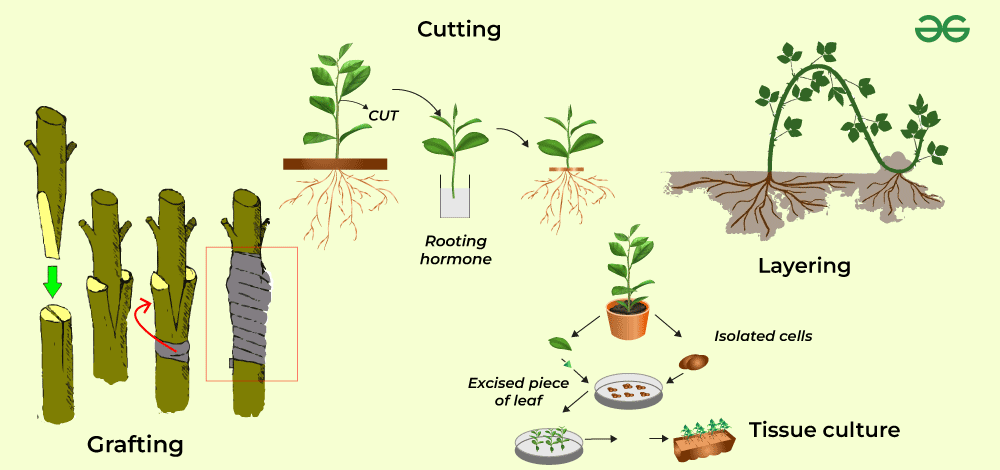
Clonal Propagation
- It is the process of asexual reproduction by multiplication of genetically identical copies of individual plants.
- It occurs by apomixis (seed development without meiosis and fertilization) and/or vegetative reproduction (regeneration of new plants from vegetative parts).
Q. Consider the following pairs:
Vitamin Deficiency – disease
- Vitamin C – Scurvy
- Vitamin D – Rickets
- Vitamin E – Night blindness
Which of the pairs given above is/are correctly matched?
(a) 1 and 2 only
(b) 3 only
(c) 1, 2 and 3
(d) None
Answer: (a) 1 and 2 only
Vitamins
- Vitamins are substances that our bodies need to develop and function normally like vitamins A, C, D, E, and K, choline, and vitamin B (thiamin, riboflavin, niacin, pantothenic acid, biotin, vitamin B6, vitamin B12, and folate/folic acid).
- They shore up bones, heal wounds, and bolster your immune system.
- They convert food into energy and repair cellular damage.
Deficiency Diseases
- A person may be getting enough food to eat, but sometimes the food may not contain a particular nutrient. If this continues over a long period of time, the person may suffer from its deficiency.
- Deficiency of one or more nutrients can cause diseases or disorders in our body. Diseases that occur due to lack of nutrients over a long period are called deficiency diseases.
- Vitamin A – Night blindness
- Vitamin B1 – Beriberi
- Vitamin B2 – Ariboflavinosis
- Vitamin B3 – Pellagra
- Vitamin B5 – Paresthesia
- Vitamin B6 – Anemia
- Vitamin B7 – Dermatitis, enteritis
- Vitamin B9 & Vitamin B12 – Megaloblastic anemia
- Vitamin C – Scurvy, Swelling of Gums
- Vitamin D – Rickets & Osteomalacia
- Vitamin E – Less Fertility
- Vitamin K – Non-Clotting of Blood.
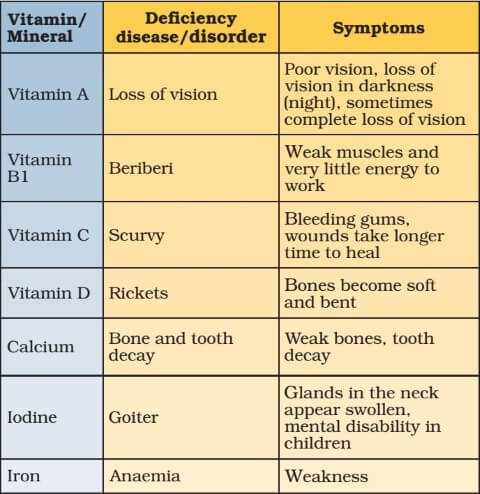
Read here: Vitamins, Minerals and Deficiency Diseases
Q. Consider the following techniques/phenomena:
- Budding and grafting in fruit plants
- Cytoplasmic male sterility
- Gene silencing
Which of the above is/are used to create transgenic crops?
(a) 1 only
(b) 2 and 3
(c) 1 and 3
(d) None
Answer: (b) 2 and 3
Transgenic Crops
- Transgenic Crops are the crops that have their genomes modified through genetic engineering techniques either by the addition of a foreign gene or removal of a certain detrimental gene.
- The aim is to introduce a new trait to the plat which does not naturally occur.
- A transgenic plant contains a gene or genes that have been artificially inserted.
- GMO vs Transgenic Organisms:
- Genetically Modified Organism (GMO) and transgenic organism are two terms that are used interchangeably.
- However, there is a slight difference between GMO and transgenic organism. Although both have altered genomes, a transgenic organism is a GMO containing a DNA sequence or a gene from a different species. While a GMO is an animal, plant, or microbe whose DNA has been altered using genetic engineering techniques.
- Thus, all transgenic organisms are GMOs, but not all GMOs are transgenic.
- Concerns related to Transgenic Crops:
- Lack Nutritional Value: GM foods can sometimes lack nutritional value despite their increased production and pest resistance focus. This is because the emphasis is often placed on enhancing certain traits rather than nutritional content.
- Risks to Ecosystems: GM production can also pose risks to ecosystems and biodiversity. It may disrupt gene flow and harm indigenous varieties, leading to a loss of diversity in the long run.
- Trigger Allergic Reactions: Genetically modified foods have the potential to trigger allergic reactions since they are biologically altered. This can be problematic for ndividuals accustomed to conventional varieties.
- Endangered Animals: Wildlife is also at risk due to GM crops. For instance, genetically modified plants used for producing plastic or pharmaceuticals can endanger animals like mice or deer that consume crop debris left in fields after harvest.
Budding and Grafting
- Budding and Grafting are horticultural techniques, Grafting is the act of placing a portion of one plant (bud or scion) into or on a stem, root, or branch of another (stock) in such a way that a union will be formed and the partners will continue to grow.
- In the budding process, a bud is taken from one plant and grown on another. It does not lead to any genetic modification.
Cytoplasmic male sterility
- Cytoplasmic male sterility is total or partial male sterility in plants as the result of specific nuclear and mitochondrial interactions.
- Male sterility is the failure of plants to produce pollen or male gametes.
- The cytoplasmic male sterility systems are widely utilized in crop plants for hybrid breeding due to the convenience of controlling sterility.
Gene Silencing
- Gene Silencing using RNA interference technology, transcriptional gene silencing, virus-induced gene silencing, has been used in horticultural techniques.
- The double-strand RNAs present inside the cell are responsible for producing small interfering RNAs, short hairpin RNAs, and micro RNAs.
Q. Among the following organisms, which one does not belong to the class of other three?
(a) Crab
(b) Mite
(c) Scorpion
(d) Spider
Answer: (a) Crab
Crustaceans
- Crustaceans are invertebrate animals of the subphylum Crustacea, a large, diverse group of mainly aquatic arthropods including decapods, seed shrimp, branchiopods, fish lice, krill, remipedes, isopods, barnacles, copepods, opossum shrimps, amphipods and mantis shrimp.
- The crustacean group can be treated as a subphylum under the clade Mandibulata.
- It is now well accepted that the hexapods (insects and entognathans) emerged deep in the Crustacean group, with the completed group referred to as Pancrustacea.
- The three classes Cephalocarida, Branchiopoda and Remipedia are more closely related to the hexapods than they are to any of the other crustaceans (oligostracans and multicrustaceans).
- Like other arthropods, crustaceans have an exoskeleton, which they molt to grow. They are distinguished from other groups of arthropods, such as insects, myriapods, and chelicerates, by the possession of biramous (two-parted) limbs, and by their larval forms, such as the nauplius stage of branchiopods and copepods.
- One of the defining characteristics of crustaceans is their jointed appendages. These limbs are adapted for various functions, such as walking, swimming, grasping, and feeding. The number and structure of their appendages vary across different species.
- Most crustaceans are free-living bottom feeders aquatic animals, but some are terrestrial (e.g. woodlice, sandhoppers), some are parasitic (e.g. Rhizocephala, fish lice, tongue worms) and some are sessile (e.g. barnacles).
- The group has an extensive fossil record, reaching back to the Cambrian.
- Many crustaceans have specialized sensory organs, including antennae, that allow them to detect changes in their environment. These sensory structures help them locate food, mates, and navigate their surroundings.
- Crustaceans contribute to the balance of ecosystems as prey for larger animals and as scavengers that help clean up decaying matter. They also act as filter feeders, consuming microscopic algae and plankton, thus regulating water quality.
- A fascinating ability of many crustaceans is their capacity to regenerate lost appendages. If a limb is damaged or lost due to predation or injury, they can regrow a new one through a process called autotomy.
- Several crustacean species, such as certain crabs and lobsters, exhibit intricate social behaviors. They establish dominance hierarchies, engage in courtship rituals, and communicate with each other using visual displays and chemical signals.
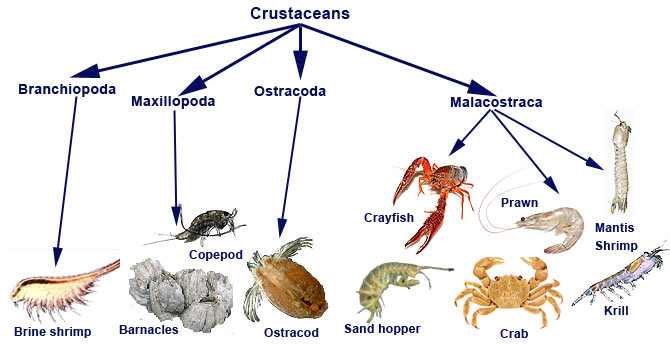
Arachnid
- Arachnida is a class of joint-legged arthropods, in the subphylum Chelicerata. Arachnida includes, among others, spiders, scorpions, ticks, mites, pseudoscorpions, harvestmen, camel spiders, whip spiders and vinegaroons.
- Almost all extant arachnids are terrestrial, living mainly on land. However, some inhabit freshwater environments and, with the exception of the pelagic zone, marine environments as well.
- Like all arthropods, arachnids have segmented bodies, tough exoskeletons, and jointed appendages. Most are predatory.
- Arachnids lack jaws and, with only a few exceptions, inject digestive fluids into their prey before sucking its liquefied remains into their mouths.
- Except among daddy longlegs and the mites and ticks, in which the entire body forms a single region, the arachnid body is divided into two distinct regions: the cephalothorax, or prosoma, and the abdomen, or opisthosoma. The sternites (ventral plates) of the lower surface of the body show more variation than do the tergites (dorsal plates).
- The arachnids have simple (as opposed to compound) eyes.
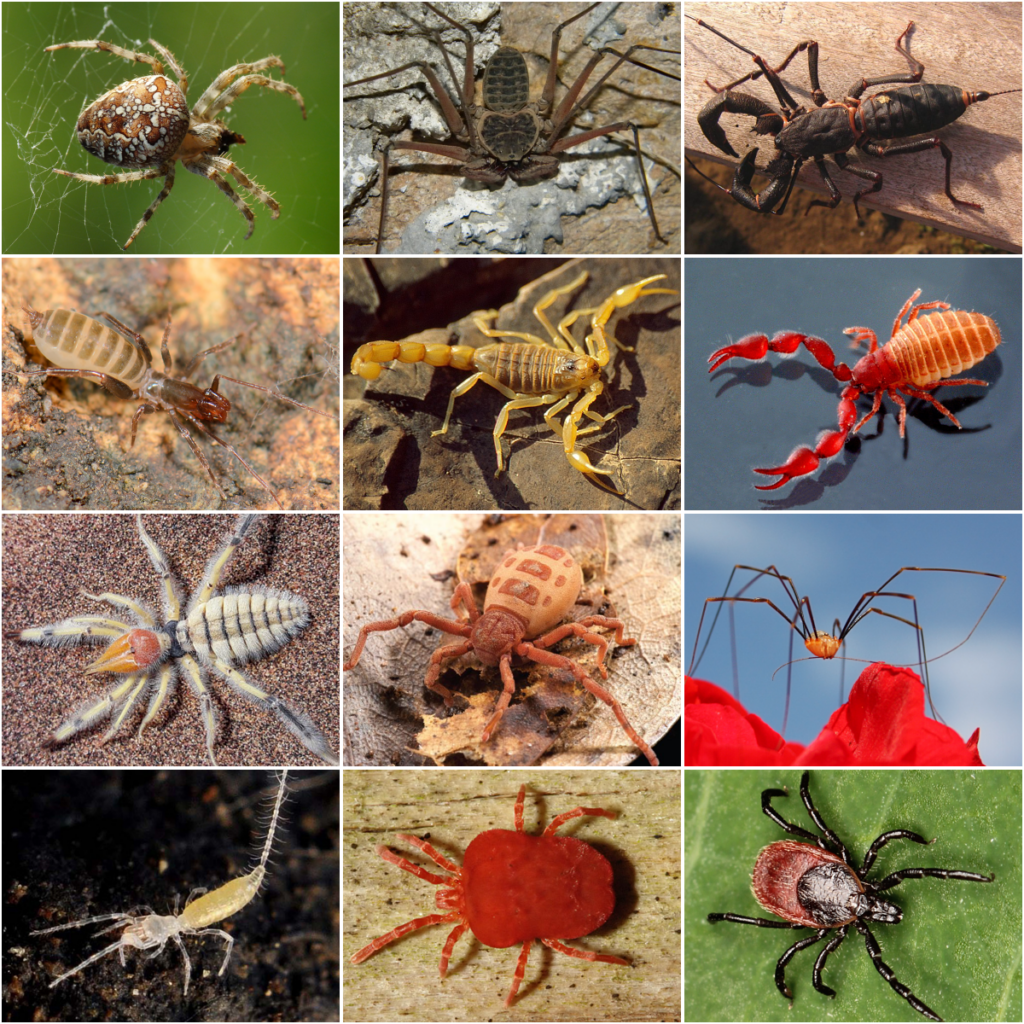
Also Read: Classification of Animal Kingdom
Q. Consider the following statements:
- Maize can be used for the production of starch.
- Oil extracted from maize can be a feedstock for biodiesel.
- Alcoholic beverages can be produced by using maize.
Which of the statements given above is/are correct?
(a) 1 only.
(b) 1 and 2 only
(c) 2 and 3 only
(d) 1, 2 and 3
Answer: (d) 1, 2 and 3
Notes
- Maize starch is produced by the wet milling process, which involves the grinding of softened maize and separation of corn oil seeds (germs), gluten (proteins), fibers (husk), and finally pure starch.
- Corn starch is made from maize kernels, which are high in starch.
- Corn starch has a wide variety of applications. It is used as a thickening agent in soups.
- Corn starch is also used in manufacturing bio-plastics and the preparation of corn syrup.
- The general way to Produce Biodiesel fuels is transesterification of fat or oil triacylglycerols with short-chain alcohol such as methanol or ethanol in the presence of alkaline or acid catalysts.
- Corn Biodiesel chemically is a mixture of long-chain fatty acid methyl esters (FAMEs).
- Oil extracted from maize that can be converted into ethanol or biodiesel.
- The type of alcohol in the alcoholic drinks we drink is a chemical called ethanol. To make alcohol, you need to put grains, fruits, or vegetables through a process called fermentation. the common source of ethanol is maize and other grains.
Biofuels
- Any hydrocarbon fuel that is produced from an organic matter (living or once living material) in a short period of time (days, weeks, or even months) is considered a biofuel.
- Biofuels may be solid, liquid or gaseous in nature.
- Solid: Wood, dried plant material, and manure
- Liquid: Bioethanol and Biodiesel
- Gaseous: Biogas
- These can be used to replace or can be used in addition to diesel, petrol or other fossil fuels for transport, stationary, portable and other applications. Also, they can be used to generate heat and electricity.
- Some of the main reasons for shifting to biofuels are the rising prices of oil, emission of greenhouse gases from fossil fuels and the interest in obtaining fuel from agricultural crops for the benefit of farmers.
- Different Categories of Biofuels:
- First Generation Biofuels:
- These are made from food sources such as sugar, starch, vegetable oil, or animal fats using conventional technology.
- Common first-generation biofuels include Bioalcohols, Biodiesel, Vegetable oil, Bioethers, Biogas.
- Though the process of conversion is easy but use of food sources in the production of biofuels creates an imbalance in the food economy, leading to increased food prices and hunger.
- Second Generation Biofuels:
- These are produced from non-food crops or portions of food crops that are not edible and considered as wastes, e.g., stems, husks, wood chips, and fruit skins and peeling.
- Examples include cellulose ethanol, biodiesel.
- Thermochemical reactions or biochemical conversion processes are used for producing such fuels.
- Though these fuels do not affect food economy, their production is quite complicated.
- Also, it is reported that these biofuels emit less greenhouse gases when compared to first generation biofuels.
- These are produced from non-food crops or portions of food crops that are not edible and considered as wastes, e.g., stems, husks, wood chips, and fruit skins and peeling.
- Third Generation Biofuels:
- These are produced from micro-organisms like algae.
- Example- Butanol
- Micro-organisms like algae can be grown using land and water unsuitable for food production, therefore reducing the strain on already depleted water sources.
- One disadvantage is that fertilizers used in the production of such crops lead to environmental pollution.
- Fourth Generation Biofuels:
- In the production of these fuels, crops that are genetically engineered to take in high amounts of carbon are grown and harvested as biomass.
- The crops are then converted into fuel using second generation techniques.
- The fuel is pre-combusted, and the carbon is captured. Then the carbon is geo-sequestered, meaning that the carbon is stored in depleted oil or gas fields or in unmineable coal seams.
- Some of these fuels are considered carbon negative as their production pulls out carbon from the environment.
- First Generation Biofuels:
- Major Types of Biofuels:
- Bioethanol
- It is derived from corn and sugarcane using fermentation process.
- A litre of ethanol contains approximately two thirds of the energy provided by a litre of petrol.
- When mixed with petrol, it improves combustion performance and lowers the emissions of carbon monoxide and sulphur oxide.
- Biodiesel
- It is derived from vegetable oils like soybean oil or palm oil, vegetable waste oils, and animal fats by a biochemical process called “Transesterification.”
- It produces very less or no amount of harmful gases as compared to diesel.
- It can be used as an alternative for to conventional diesel fuel.
- Biogas
- It is produced by anaerobic decomposition of organic matter like sewage from animals and humans.
- Major proportions of biogas are methane and carbon dioxide, though it also has small proportions of hydrogen sulfide, hydrogen, carbon monoxide and siloxanes.
- It is commonly used for heating, electricity and for automobiles.
- Biobutanol
- It is produced in the same way as bioethanol, i.e., through the fermentation of starch.
- The energy content in butanol is the highest among the other gasoline alternatives. It can be added to diesel to reduce emissions.
- It serves as a solvent in textile industry and is also used as a base in perfumes.
- Biohydrogen
- Biohydrogen, like biogas, can be produced using a number of processes such as pyrolysis, gasification or biological fermentation.
- It can be the perfect alternative for fossil fuel.
- Bioethanol
Q. Consider the following diseases
- Diphtheria
- Chickenpox
- Smallpox
Which of the above diseases has/have been eradicated in India?
(a) 1 and 2 only
(b) 3 only
(c) 1, 2 and 3
(d) None
Answer: (b) 3 only
Notes:
- Polio and small pox are both diseases that are completely eradicated now.
- With the help of vaccination drive and awareness, the small pox was eradicated first and recently polio was also eradicated in India.
- Measles is in control due to vaccination but it is not completely eradicated in India.
Smallpox
- Smallpox was a serious infectious disease caused by the Variola virus.
- Smallpox was eradicated, and no cases of naturally occurring smallpox have happened since 1977.
- It was mainly spread by direct and fairly prolonged face-to-face contact between people.
Diphtheria
- Diphtheria is a serious bacterial infection that affects the mucous membranes of the throat and nose.
- A type of bacteria called Corynebacterium diphtheriae causes diphtheria.
Chickenpox
- The chickenpox infection caused by the Varicella-zoster virus (VZV).
- The virus can spread through: saliva, coughing, sneezing, contact with fluid from the blisters.
Q. Consider the following:
- Bats
- Bears
- Rodents
The phenomenon of hibernation can be observed in which of the above kinds of animals?
(a) 1 and 2 only
(b) 2 only
(c) 1, 2 and 3
(d) Hibernation cannot be observed in any of the above
Answer: (c) 1, 2 and 3
Hibernation
- Hibernation is a state of minimal activity and metabolic depression undergone by some animal species. Hibernation is a seasonal heterothermy characterized by low body-temperature, slow breathing and heart-rate, and low metabolic rate.
- It is found in bats, bears, rodents etc. It most commonly occurs during winter months.
- Hibernation functions to conserve energy when sufficient food is not available. To achieve this energy saving, an endothermic animal decreases its metabolic rate and thereby its body temperature.
- Hibernation may last days, weeks, or months—depending on the species, ambient temperature, time of year, and the individual’s body-condition.
- Before entering hibernation, animals need to store enough energy to last through the duration of their dormant period, possibly as long as an entire winter. Larger species become hyperphagic, eating a large amount of food and storing the energy in their bodies in the form of fat deposits.

Q. Which of the following adds/add carbon dioxide to the carbon cycle on the planet Earth?
- Volcanic action
- Respiration
- Photosynthesis
- Decay of organic matter
Select the correct answer using the code given below.
(a) 1 and 3 only
(b) 2 only
(c) 1, 2 and 4 only
(d) 1, 2, 3 and 4
Answer: (c) 1, 2 and 4 only
Notes:
- The Process of photosynthesis takes up Carbon dioxide and release oxygen. Hence photosynthesis does not add carbon dioxide to the carbon cycle.
- Volcanic action leads to the release of Carbon dioxide.
- Respiration is the movement of oxygen from the outside environment to the cells within tissues and the release of carbon dioxide in the opposite direction.
- The process of decomposition releases Carbon dioxide.
Q. Which of the following pair(s) is/are correctly matched?
| Spacecraft | Purpose | ||
| 1. | Cassini-Huygens | : | Orbiting the Venus and transmitting data to the Earth |
| 2. | Messenger | : | Mapping and investigating the Mercury |
| 3. | Voyager 1 & 2 | : | Exploring the outer solar system |
Select the correct answer using the codes given below.
(a) 1 only
(b) 2 and 3 only
(c) 1 and 3 only
(d) 1, 2 and 3
Answer: (b) 2 and 3 only
Cassini–Huygens
- Cassini–Huygens, commonly called Cassini, was a space-research mission by NASA, the European Space Agency, and the Italian Space Agency to send a space probe to study the planet Saturn and its system, including its rings and natural satellites.
- It took us to astounding worlds where methane rivers run to a methane sea and where jets of ice and gas are blasting material into space from a liquid water ocean that might harbor the ingredients for life.
MESSENGER
- MESSENGER was a NASA robotic space probe that orbited the planet Mercury between 2011 and 2015, studying Mercury’s chemical composition, geology, and magnetic field.
- The name is a backronym for “Mercury Surface, Space Environment, Geochemistry, and Ranging”.
Voyager program
- The Voyager program is an American scientific program that employs two robotic interstellar probes, Voyager 1 and Voyager 2.
- They were launched in 1977 to take advantage of a favorable alignment of the two gas giants Jupiter and Saturn and the ice giants, Uranus and Neptune, to fly near them while collecting data for transmission back to Earth.
- After launch, the decision was made to send Voyager 2 near Uranus and Neptune to collect data for transmission back to Earth.

Q. With reference to Agni-IV Missile, which of the following statement(s) is/are correct?
- It is surface-to-surface missile.
- It is fuelled by liquid propellant only.
- It can deliver one tonne nuclear warhead about 7500 km away.
Select the correct answer using the codes given below.
(a) 1 only
(b) 2 and 3 only
(c) 1 and 3 only
(d) 1, 2 and 3
Answer: (a) 1 only
Agni-4 Missile
- The surface to surface Agni-IV missile having 4000 km strike range is a two stage missile.
- The missile is light-weight and has two stages of solid propulsion and a payload with re-entry heat shield. It is 20-metre long and weighs 17 tonnes.
- It is equipped with modern and compact avionics to provide a high level of reliability.
- It is an Intermediate Range Ballistic Missile with a range of around 4,000 km. Developed by the Defence Research and Development Organisation (DRDO).
- Features:
- It is equipped with state-of-the-art Avionics, 5th generation On Board Computer and distributed architecture.
- It has the latest features to correct and guide itself for in-flight disturbances.
- The most accurate Ring Laser Gyro based Inertial Navigation System (RINS) and supported by the highly reliable redundant Micro Navigation System (MINGS), ensures the vehicle reaches the target within two digit accuracy.
- Range of other Agni Missiles:
- Agni I: Range of 700-800 km.
- Agni II: Range more than 2000 km.
- Agni III: Range of more than 2,500 Km
- Agni IV: Range is more than 3,500 km and can fire from a road mobile launcher.
- Agni-V: The longest of the Agni series, an Inter-Continental Ballistic Missile (ICBM) with a range of over 5,000 km.
IGMDP (Integrated Guided Missile Development Program)
- It was conceived by Dr. A.P.J. Abdul Kalam to enable India attain self-sufficiency in the field of missile technology. It was approved by the Government of India in 1983 and completed in March 2012.
- The 5 missiles (P-A-T-N-A) developed under this program are:
- Prithvi: Short-range surface-to-surface ballistic missile.
- Agni: Ballistic missiles with different ranges, i.e., Agni (1,2,3,4,5)
- Trishul: Short-range low-level surface to air missile.
- Nag: 3rd generation anti-tank missile.
- Akash: Medium-range surface-to-air missile.
Q. With reference to technologies for solar power production, consider the following statements:
- ‘Photovoltaics’ is a technology that generates electricity by direction conversion of light into electricity, while ‘Solar Thermal’ is a technology that utilizes the Sun’s rays to generate heat which is further used in electricity generation process.
- Photovoltaics generate Alternating Current (AC), while solar Thermal generates Direct Current (DC).
- India has manufacturing base for Solar Thermal technology, but not for Photovoltaics.
Which of the statement(s) given above is/are correct?
(a) 1 only
(b) 2 and 3 only
(c) 1, 2 and 3
(d) None
Answer: (a) 1 only
Notes
- Photovoltaic (PV) devices generate electricity directly from sunlight using PV cells made up of semiconductors.
- Photovoltaic devices convert optional radiation into electricity.
- Several solar thermal systems can collect and transform radiant energy received from the sun into high-temperature thermal (heat) energy, which can be used directly or converted into electricity.
- Solar energy can be converted directly into electrical energy (direct current, DC) by photovoltaic (PV) cells commonly called solar cells.
- India has a manufacturing base for Solar Thermal technology as well as for Photovoltaics.

Q. Brominated flame retardants are used in many household products like mattresses and upholstery. Why is there some concern about their use?
- They are highly resistant to degradation in the environment.
- They are able to accumulate in humans and animals.
Select the correct answer using the code given below.
(a) 1 only
(b) 2 only
(c) Both 1 and 2
(d) Neither 1 nor 2
Answer: (c) Both 1 and 2
Brominated flame retardants (BFRs)
- Brominated flame retardants (BFRs) belong to a large class of compounds known as organohalogens.
- BFRs have an inhibitory effect on combustion chemistry and tend to reduce the flammability of products containing them.
- They are effective in plastics and textile applications like electronics, clothes, and furniture. They are also used in many household products like mattresses and upholstery.
- Some brominated flame retardants, such as hexabromocyclododecane (HBCD), persist and bioaccumulate in the environment, potentially having toxic effects on organisms.
- They can accumulate in humans and animals causing many diseases.
- There is also concern that levels could cause adverse effects in sensitive human populations such as young children, indigenous peoples, and fish consumers.
- They are highly resistant to degradation in the environment.
Q. There is some concern regarding the nanoparticles of some chemical elements that are used by the industry in the manufacture of various products. Why?
- They can accumulate in the environment, and contaminate water and soil.
- They can enter the food chains.
- They can trigger the production of free radicals.
Select the correct answer using the codes given below:
(a) 1 and 2 only
(b) 3 only
(c) 1 and 3 only
(d) 1, 2 and 3
Answer: (d) 1, 2 and 3
Nanoparticles
- A nanoparticle is defined as a particle of matter that is between 1 and 100 nanometres (nm) in diameter. Nanoparticles are formed through the breaking down of larger particles or by controlled assembly processes.
- Due to their ultrafine size, they can be suspended in the atmosphere for a long time and can travel larger distances. They possess very little mass but are many in number.
- Nanoparticles are used in the manufacture of scratchproof eyeglasses, crack-resistant paints, anti-graffiti coatings for walls, transparent sunscreens, stain-repellent fabrics, self-cleaning windows, and ceramic coatings for solar cells.
- Nanoparticles can also be used in stronger, lighter, cleaner, and “smarter” surfaces and systems.
- The toxicity of nanoparticles depends on their chemical composition. The properties of particles may change in unpredictable ways at nanoparticle form.
- Nanoparticle is responsible for the formation of dust clouds, Ozone depletion, environmental hydroxyl radical concentration, and stratospheric temperature changes.
Impact of Nanoparticles:
- They can accumulate in the environment, and contaminate water and soil.
- They can enter food chains.
- They can trigger the production of free radicals.
- Nanoparticles may cross cell membranes.
- Nanoparticles can reach the blood and may reach other target sites such as the liver, heart, or blood cells and may cause damage to cells as they stay for a persistently long time.
Role of nanoparticles in air pollution:
- Unlike their larger-sized soot particles (black carbon), nanoparticles can be activated as cloud droplets. High concentrations of these droplets increase the proportion of solar radiation reflected back to space, causing a cooling effect on climate.
- Long exposures to high concentrations of nanoparticles cause lung problems and cardiovascular disease.
- One of the key reasons for their negative health impact is their toxicity and large total surface area per unit mass. This increases their potential chemical reactivity and ability to be absorbed. They can pass deep into the respiratory system, reacting with the lung tissues and potentially entering the bloodstream.
- Infant mortality, neonatal complications and birth defects are likely to increase with increasing concentrations of matter smaller than 10 µm.
- As per a recent study, the number of black carbon particles that enter the mother is passed on proportionally to the baby.
Q. In India, cluster bean (Guar) is traditionally used as a vegetable or animal feed, but recently the cultivation of this has assumed significance. Which one of the following statements is correct in this context?
(a) The oil extracted from seeds is used in the manufacture of biodegradable plastics
(b) The gum made from its seeds is used in the extraction of shale gas
(c) The leaf extract of this plant has the properties of anti-histamines
(d) It is a source of high quality biodiesel
Answer: (b) The gum made from its seeds is used in the extraction of shale gas
Cluster bean (Guar)
- Cluster bean (Guar) is native to India and is widely grown in dry, warm, and arid regions.
- The guar or cluster bean is an annual legume and the source of Guar gum. Guar gum is derived from guar seeds, a legume crop that grows in semi-arid regions of Rajasthan, Gujarat and Haryana.
- The gum made from its seeds is used in the extraction of shale gas.
- Guar gum is used as a stabilizing, thickening and suspending agent in drilling fluids.
- It is traditionally used as a vegetable or animal feed.
- This legume is a valuable plant in a crop rotation cycle, as it lives in symbiosis with nitrogen-fixing bacteria.
- India is the world’s largest producer of guar.

Q. With reference to two non-conventional energy sources called ‘coalbed methane’ and ‘shale gas’, consider the following statements:
- Coalbed methane is the pure methane gas extracted from coal seams, while shale gas is a mixture of propane and butane only that can be extracted from fine-grained sedimentary rocks.
- In India, abundant coalbed methane sources exist, but so far no shale gas sources have been found.
Which of the statement(s) given above is/are correct?
(a) 1 only
(b) 2 only
(c) Both 1 and 2
(d) Neither 1 nor 2
Answer: (d) Neither 1 nor 2
Coalbed methane
- Coal bed methane (CBM) is an unconventional form of natural gas found in coal deposits or coal seams.
- It is a primary clean energy source of natural gas. It is called ‘sweet gas’ because of its lack of hydrogen sulfide.
- The presence of this gas is well known from its occurrence in underground coal mining.
- Unlike much natural gas from conventional reservoirs, coalbed methane contains very little heavier hydrocarbons such as propane or butane, and no natural-gas condensate. It often contains up to a few percent carbon dioxide.
- Gas contained in coal bed methane is mainly methane and trace quantities of ethane, nitrogen, carbon dioxide and few other gases.
- Coalbed methane is generally formed due to thermal maturation of kerogen and organic matter.
- With one of the largest proven coal reserves, and one of the largest coal producer in the world, India holds significant prospects for commercial recovery of coalbed methane.
- The Gondwana sediments of eastern India host the bulk of India’s coal reserves and all the current CBM producing blocks. The vast majority of the best prospective areas for CBM development are in eastern India, situated in Damodar Koel valley and Son valley.
- CBM projects exist in Raniganj South, Raniganj East and Raniganj North areas in the Raniganj coalfield, the Parbatpur block in Jharia coalfield and the East and west Bokaro coalfields. Son valley includes the Sonhat North and Sohagpur East and West blocks.
Shale Gas
- Shales are fine-grained sedimentary rocks formed of organic-rich mud at the bottom of ancient seas.
- Subsequent sedimentation and the resultant heat and pressure transformed the mud into shale and also produced natural gas from the organic matter contained in it.
- Over long spans of geologic time, some of the gas migrated to adjacent sandstones and was trapped in them, forming conventional gas accumulations. The rest of the gas remained locked in the nonporous shale.
- Shale gas and oil are unconventional natural resources.
- Shale gas is natural gas and is a hydrocarbon gas mixture.
- It consists mainly of methane.
- It contains other hydrocarbons like ethane, propane, and butane, and it also contains carbon dioxide, nitrogen, and hydrogen sulfide.
- India has identified six basins as areas for shale gas exploration:
- Cambay (Gujarat), Assam-Arakan (North East), Gondwana (Central India), Krishna Godavari onshore (East Coast), Cauvery onshore, and Indo-Gangetic basins.
- Extraction of Shale Gas:
- Shale gas occurs frequently at depths exceeding 1,500 metres (5,000 feet).
- Extraction is done through horizontal drilling through the shale seam, followed by hydraulic fracturing, or fracking, of the rock by the injecting of fluid at extremely high pressure.
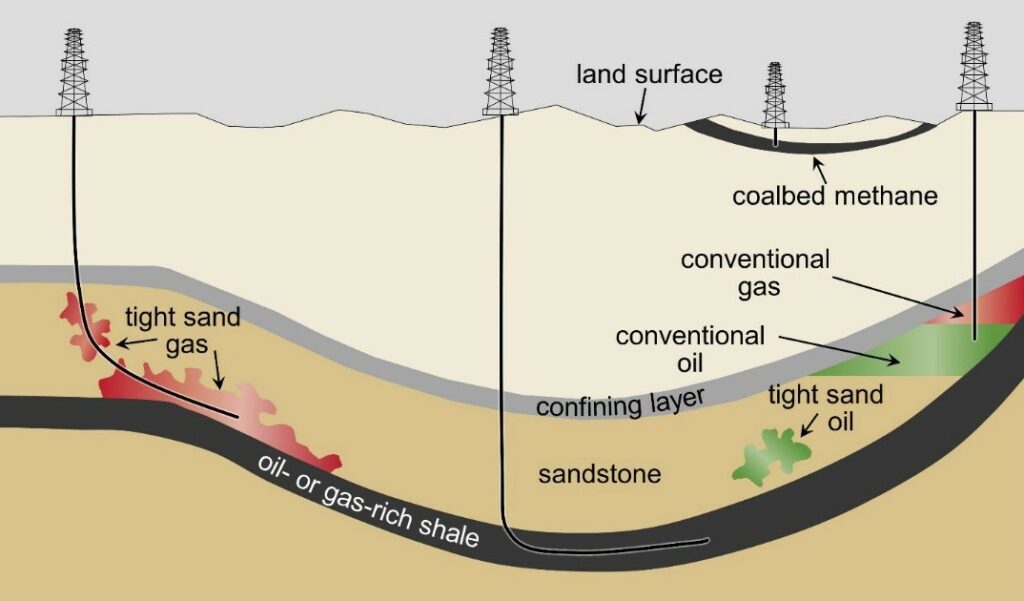
Q. In addition to fingerprint scanning, which of the following can be used in the biometric identification of a person?
- Iris scanning
- Retinal scanning
- Voice recognition
Select the correct answer using the code given below.
(a) 1 only
(b) 2 and 3 only
(c) 1 and 3 only
(d) 1, 2 and 3
Answer: (d) 1, 2 and 3
Notes
- Biometric identification consists of determining the identity of a person. The aim is to capture an item of biometric data from this person. It can be a photo of their face, a record of their voice, or an image of their fingerprint.
- Here are some common examples of biometric security:
- Voice Recognition
- Fingerprint Scanning
- Facial Recognition
- Iris Recognition
- Heart-Rate Sensors
- Iris scanning
- It is the process of using visible and near-infrared light to take a high-contrast photograph of a person’s iris.
- It is a form of biometric technology.
- Retinal scanning
- It maps the unique patterns of a person’s retina.
- The blood vessels within the retina absorb light more readily than the surrounding tissue and are easily identified with appropriate lighting.
- It is highly accurate and difficult to spoof, in terms of identification.
- Voice recognition
- It is a computer software program with the ability to decode the human voice.
- It is used to operate a device or perform commands.
